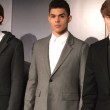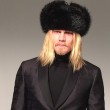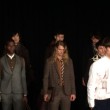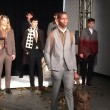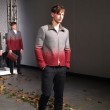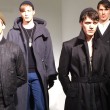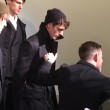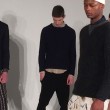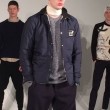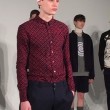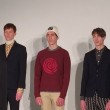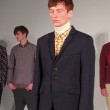Fingers Crossed, Garciavalez, David Hart, Ernest Alexander, Cadet and Lucio Castro showed their Fall 2015 collections at New York Men’s Day (NYMD) sponsored by Cadillac at Industria Studios.
Fingers Crossed:
Fingers Crossed designer Ryu Hayama debuted his third collection, Abssyopelagic, which takes its inspiration from the sea and those who sail it. Hayama has taken the classic mariner wear and modernized it, resulting in a unique form of work wear. Its colors are mostly dark, with two-tone greys, navy blues, and the occasional splash of yellow. While mariners were undoubtedly a basis for the designs, the sea itself is also seen in the clothes. The lines Hayama creates seem to evoke the ebbing and flowing, the predictable yet surprising nature of the open waters.
Garciavalez:
Newcomer Garciavalez had its debut with its Autumn/Winter 2015 collection. Started by architect Carlos Garciavalez, his assortment of menswear is notable for its complex and unexpected lines, creating a fresh look unseen in traditional menswear. His unconventional choices create a depth and texture that’s unexpected and distinctive, inspired by his background as a working architect. Featuring deep, dark colors, the collection is formal yet functional, a part of the current athleisure trend. Garciavalez’s unique background enable him to bring out the contours and hidden depth of the male form in which few other designers can.
David Hart:
This collection features clothing inspired by the Old West. Or, rather, the lens through which Hollywood filtered, distilled, and glorified the Old West. One of the most noticeable aspects about this collection is its color pallet: It’s bright, featuring plenty of reds and oranges, with the occasional sky blue — an homage to the Western landscape, a crucial aspect to the Old West myth. David Hart’s Autumn/Winter 2015 collection brings Western work wear to the 21st century, tightening it while combining period and modern prints to create a truly unique look.
Ernest Alexander:
The title for this collection is “A Wandering Traveler.” And the name fits. The collection is based on a very defined concept: The introduction of nature and culture into a man’s clothing as he wanders the American landscape. This is immediately evident in the clothes, which are rife with earth tones and the colors of the forest. As the man goes farther and farther on his journey, his progress is evident in the clothes he’s crafted, going from the forests of the east to the harsh deserts of the southwest, where the pop of the oranges and reds is incorporated, evoking the vibrancy and sheer scope of the American landscape.
Cadet:
It doesn’t take long to decipher the inspiration for this collection. In fact, it’s in right in the name: “Wartime Restrictions” from Cadet. The collection draws inspiration from the rationing of supplies during World War II, when everything was carefully counted, and supplies were painfully tight for those at home and abroad. The clothes are dark, with plenty of blacks, blues, and olives, evoking the military influence of the styles. Formal wear is liberally mixed with more military garb and utilitarian fare, capturing and commenting on the way social and economic factors shape our lives, down to the very clothes we wear.
Lucio Castro:
Ubu Roi is the title of a controversial play by Alfred Jarry, first performed in the late 1800s. It was ahead of its time in ways the audience wasn’t prepared for, causing riots that ensured its opening night was also its closing. But Ubu Roi also signaled the beginning of modernism, sending the theatre into an entirely new and unexpected generation of theatre. It is from a 1965 film adaptation of this play that Lucio Castro draws its inspiration from. Deep reds stand out from the more understated colors, evoking royalty and significance. Repetition is the name of the game here, with wild, hypnotic, and nonsensical patterns distorting otherwise conventional and recognizable clothing items, much in the way Jarry played with and distorted longstanding and recognizable forms of theatre.
-Stephen Jones










